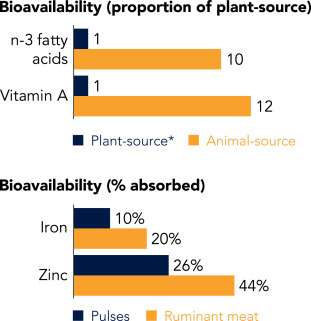
There has been a lot of discussion about the health and environmental benefits and risks of animal-source foods (which include meat, fish, eggs and dairy). This paper examined the current evidence on these benefits and risks, finding that these impacts vary massively depending on local context and population development.
This paper critically reviewed current evidence on the health and environmental benefits and risks of animal-source foods (ASFs), which include meat, fish, eggs, and dairy. The major finding of this study was that the health and environmental impacts of ASFs vary massively depending on local context and population development and this must be accounted for in policy decisions.
Due to their nutrient rich nature ASFs can help combat nutrient deficiencies and malnutrition, particularly in low-income countries in Sub-Saharan Africa and South Asia. For example, ASFs are the only food-source for vitamin B12 and contain more bioavailable forms of vitamin A, vitamin D, iron, zinc, and n-3 fatty acids than plant-source foods (PSFs, all foods derived from plants). Deficiencies in all these micronutrients can have severe health impacts. The figure below compares the bioavailability of some of these micronutrients in ASFs and PSFs. Overall, ASFs contain both essential nutrients and bioactive compounds that play vital roles in human health, and in some cases, these constituents are not found in PSFs.

Image: Figure 1, Beal et al., 2023. Nutrient bioavailability differences between plant and animal sources. Bioavailability estimates of n–3 fatty acids, vitamin, and iron and zinc are given. ∗Only terrestrial plant sources of n–3 fatty acids are shown here; sea vegetables contain long-chain n–3 fatty acids and have similar bioavailability as that of animal sources.
However, the study also showed that excessive consumption of processed meat, red meat, and saturated fats, especially in high-income countries, presents a major health risk in terms of non-communicable diseases. Finally, whilst ASFs production can have major environmental impacts, if sustainable production methods are used it can contribute to diverse agroecosystems, restore degraded land, and mitigate climate change, all whilst boosting food security.
Overall, ASFs can have both benefits and risks when it comes to their health and environmental impacts. These vary depending on local contexts and levels of population development, which must be accounted for to ensure best practice in policy decisions.
Abstract
Scientific and political discussions around the role of animal-source foods (ASFs) in healthy and environmentally sustainable diets are often polarizing. To bring clarity to this important topic, we critically reviewed the evidence on the health and environmental benefits and risks of ASFs, focusing on primary trade-offs and tensions, and summarized the evidence on alternative proteins and protein-rich foods. ASFs are rich in bioavailable nutrients commonly lacking globally and can make important contributions to food and nutrition security. Many populations in Sub-Saharan Africa and South Asia could benefit from increased consumption of ASFs through improved nutrient intakes and reduced undernutrition. Where consumption is high, processed meat should be limited, and red meat and saturated fat should be moderated to lower noncommunicable disease risk—this could also have cobenefits for environmental sustainability. ASF production generally has a large environmental impact; yet, when produced at the appropriate scale and in accordance with local ecosystems and contexts, ASFs can play an important role in circular and diverse agroecosystems that, in certain circumstances, can help restore biodiversity and degraded land and mitigate greenhouse gas emissions from food production. The amount and type of ASF that is healthy and environmentally sustainable will depend on the local context and health priorities and will change over time as populations develop, nutritional concerns evolve, and alternative foods from new technologies become more available and acceptable. Efforts by governments and civil society organizations to increase or decrease ASF consumption should be considered in light of the nutritional and environmental needs and risks in the local context and, importantly, integrally involve the local stakeholders impacted by any changes. Policies, programs, and incentives are needed to ensure best practices in production, curb excess consumption where high, and sustainably increase consumption where low.
Reference
Beal, T., Gardner, C.D., Herrero, M., Iannotti, L.L., Merbold, L., Nordhagen, S. and Mottet, A., 2023. Friend or Foe? The Role of Animal-Source Foods in Healthy and Environmentally Sustainable Diets. The Journal of Nutrition, In Press, Corrected Proof.
Read the full paper here. See also the TABLE Letterbox series Vegan or flexitarian - which diet is healthier?







Post a new comment »